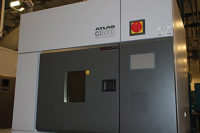Manufacturers of products ranging from military airplanes to lawnmowers all have something in common; each needs to be confident that their product can withstand the environmental conditions that their materials and components might be exposed to. Performing environmental testing that encompasses all environmental factors and the wider manufacturing process is critical and while the most accurate evaluation that can be performed is in real time and in the physical environment that is being tested for, such tests can take years to complete and cost a substantial amount. Accelerated tests provide significant savings, allowing manufacturers to narrow down a selection of proposed processes or to know if adjustments need to be made in a product or process in a timely manner.
Environmental conditions considered in accelerated tests typically include sunlight, swift temperature changes, humidity, water and salt. Such environmental effects may be commonplace, but having the capability to test and qualify a material or product under one (and especially a combination) of the above is certainly not straightforward. Multiple factors can affect results, and not just in a material’s composition; machining, application and heat treatment all have a significant impact and need to be considered when simulating performance in real world conditions.
There are two distinct types of environmental testing that are most common. The first is to conduct routine production testing to ensure regulatory requirements are met. Many purchasers require verification of a product from suppliers to an industry standard. These standards, outlined previously in a May 2013 feature in QualityMagazine, demand stringent test methodologies that are predetermined, ensuring that all data produced is reliable and consistent. Teams of specialist experts also directly assist the manufacturing and design teams of customers who are researching and developing new products or manufacturing processes. These experts can then assess and perhaps even create test programs and methodologies to evaluate and validate them. To do this, specialists must work in partnership with customers to determine the challenges being faced to provide the exact set of answers they need.
It is essential to consider all requirements and apply both experience and knowledge to assess which test program will deliver the most realistic data. For example, a customer might initially seek a specific corrosion test that does not deliver a truly accurate representation of the real-world application of their product. Recently, the team here was asked to perform a salt spray test on a coating at a pre-set temperature. After consultation it was decided that carrying out the test at a slightly different temperature (resulting in completely different types of corrosive attack) was a more accurate simulation. The team created a set of tests individually tailored to reflect the unique conditions the coating would be exposed to; this not only determined if the product was suitable and helped engineers to refine it, but also whether the product was applied correctly. The range of standard testing can typically include:
TECH TIPSMachining, application and heat treatment all have a significant impact on ultimate performance in real world conditions, and therefore performing environmental testing that encompasses these and the wider manufacturing process is critical. Specialist materials testing and product qualification experts can directly assist manufacturing and design teams who are researching and developing new products or manufacturing processes requiring validation. Care must be taken when performing accelerated tests; as a general rule, when acceleration increases, so too does the deviation from real world results. Accelerated testing of critical products should always be verified with a real world test. |
Temperature
Inducing ambient temperatures and sudden changes is a fundamental aspect of most test programs. Consistent fluctuations can cause components to expand and contract, leading to cracking and possible failure, while tests involving extreme cold and heat are also common. Temperature shock can be a prime environmental issue, especially for partners involved in demanding markets like aerospace and oil and gas. To achieve such a wide range of tests, an environmental chamber is typically capable of cycling between -100F and 350F while also precisely controlling humidity. The team recently simulated an automated machine in Alaskan conditions and a rapid cooling effect was needed to reflect moving the product from indoors to outside. Tests had to determine even the most minor issues, such as whether grease in mechanical parts froze or if electronics failed if suddenly brought from room temperature to below freezing. With the chamber capable of producing up to 95% humidity, the team conducted a range of tests at variable temperatures. The results identified a need for a warm-up period prior to startup in certain inclement conditions.
Salt/acid spray
By using an adjustable fog dispersion system to spray an atomized salt or acid solution, one that can vary volume and distance, coatings can be better tested for corrosion resistance and durability to various forms of attack. A salt or acid spray chamber can also be set up to incorporate adjustable temperature and humidity, affording greater control over dry-off exposures. With corrosive properties depending on a multitude of environmental factors, salt and acid spray standards can often exclude many important factors that might impact a product in its final environment. It is critical that the appropriate knowledge and equipment be leveraged to achieve the most satisfactory results.
UV/Xenon exposure
Prolonged exposure to sunlight can have a negative impact on coatings such as paint and other materials and materials such as polymers are particularly susceptible to material changes under UV and xenon light. Effects can be both aesthetic and create a deterioration in performance, including degradation, discoloration, chalking, blistering and oxidization.
While accelerated testing cannot fully substitute for real-world, real-time testing, accurate simulation is always a driving factor when conducting environmental evaluation and there is a constant trend towards better replicating the real-world conditions to which materials and components will be exposed. A range of test chambers and enclosures allow testing of various effects in the specified environmental conditions outlined above, but cyclical testing is emerging as an increasingly popular method by which to test a range of individual factors in tandem.
Cyclical testing combines elements of individual tests and in doing so can provide a more comprehensive overview of how test material might react to multiple effects simultaneously. For instance, salt spray and UV exposure when combined can find a failure mechanism which separate tests might not detect. UV degradation often initially results in very small crevices that might not have any discernible effect when considered by itself. But when salt spray is introduced, as a material is expanding and contracting due to temperature, the chloride can wedge in crevices and rapidly increase crevice size and failure rate. Some of the latest cyclical tests, where each effect can also be tested separately, are:
Cyclic UV and dew exposure
Photodegradation via sunlight can be exacerbated over time by extended exposure to dew, which is the primary source of wetness in real-world environments, not rain. To simulate outside weathering, materials can be exposed to alternating cycles of UV light and moisture at controlled, elevated temperatures. The dew is baked off by the simulated sunlight and later temperature shocks the hot material when reapplied, with the cycle repeated for the duration of the test. The effect is achieved using a combination of fluorescent UV lamps and condensing humidity or water spray in a dedicated chamber. This allows for materials or products to be tested for any effects a combination of dew and sunshine might have, with passage of time accelerated artificially by artificially increasing the temperature or UV output in the chamber.
Cyclic corrosion and salt/water/acid fog
In some scenarios, conventional salt spray tests cannot fully reproduce the natural cycles of the outdoors. To better mimic reality, specimens can be introduced to various different environments in a repetitive cycle. Prohesion testing is designed to evaluate how well coatings, for instance the paint on a car, protect substrates from corrosion during cycles between salt fog and dry conditions. This type of test can also incorporate more complex, multi-step cycles, including humidity or condensation into the process.
Cyclic temperature and humidity, with vibration
Products can be adversely impacted by vibration in conjunction with both temperature and humidity. To accurately assess performance in such environments, a test chamber with removable floor can be configured to allow integration with vibration test systems, such as a shaker table. This custom design enables vibration testing to be paired with fast temperature changes and up to 100% humidity, even with significant loads.
While cyclical testing offers some significant advantages and enhanced results, it is important to note that it is not always the most appropriate methodology and has to be considered alongside all other available options.



